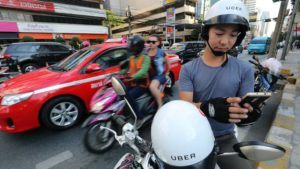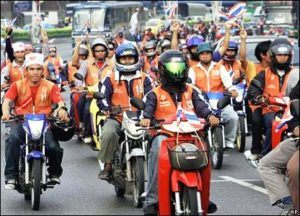UberMOTO: A Challenge to Bangkok’s Motorcycle Taxis Business Model

Bangkok’s traffic is a nightmare. With nearly 7 million residents, Bangkok is Thailand’s largest city and the second largest metropolitan in Southeast Asia [1]. Despite the city’s enormous population and economic importance, its public transportation infrastructure remains heavily underinvested and inadequate, resulting in serious congestion and chronic traffic throughout the city. [2]
Over the years, many alternative means of transportation have become popular among Bangkok commuters: Tuk-Tuk, water taxi, commuter vans and even three-wheeler taxi! Nonetheless, nothing has become more popular than motorcycle taxi – the fastest and the cheapest mode of transportation in Bangkok.
Fast, Cheap, and Everywhere!
Motorcycle taxis are everywhere in Bangkok, from the city’s most luxurious Central Business District (CBD) to its most rundown, crime-ridden neighborhood. Strictly regulated by the government, motorcycle taxi drivers are registered with the Department of Land Transportation and required to wear distinctive orange jacket as their uniform. Typically, they are organized into a “win,” a group of 20-40 local drivers that autonomously sets price, manages shifts and operates within specific its neighborhood. Because Bangkok lacks integrated and extensive public transportation system, commuters rely on motorcycle taxis to get from home to the nearest train station (out-and-back) as well as to hop between train and bus stations (inter-hub).
So, what sets motorcycle taxis apart from other modes of transportation? First, they save commuters huge amount of time by avoiding crazy rush-hour traffic. While personal cars, buses and taxis get stuck in traffic for hours, motorcycle taxis manage to sneak swiftly in between cars and trucks stuck at the traffic light. Second, motorcycle taxi ride costs considerably less than other transportation options. With these clear competitive edges, motorcycle taxi wins have become lucrative businesses that employ over 90,000 drivers across Bangkok. [3]
However, motorcycle taxi has one serious drawback: extremely inconvenient and unreliable pickup. Unlike sedan taxis, commuters cannot call motorcycle taxis to arrange for a pickup ahead of time. In most cases, commuters have to hail the motorcycle taxis dangerously on the street and often times walk some distance to the nearest win, which can be miserable in Bangkok’s 100-degree summer or months-long rainy season.
Tech Giant Taking on Local Drivers
“Motorcycles are part of the commuting culture in Thailand… Uber’s goal is to provide safe, affordable, reliable transportation at the push of a button, everywhere for everyone.” – Douglas Ma, Uber’s head of Asia Expansion [4]
https://www.youtube.com/watch?v=nO48P5wkk_Y
Realizing motorcycle taxi’s market potential and troublesome pickup process, Uber launched in February 2016 motorcycle taxi-like services on its mobile application, UberMOTO. [5] [6] The company leveraged on its existing mobile application infrastructure and cutting edge GPS technology [7] to compete head on with the traditional motorcycle taxis by allowing UberMOTO riders to pinpoint their exact pickup locations and to receive an estimated pickup time.
Further, Uber introduced a cash payment option in addition to its traditional credit card payment in order to cater to low-to-middle income commuters who prefer cash transactions. [8] Similar to UberX and UberBlack, UberMOTO enables two-way feedback between riders and drivers, reveals the driver identity to the rider and conducts background check on all of its UberMOTO drivers in order to deliver great customer experience and ensure commuter safety. [9] Uber not only was able to keep UberMOTO’s price point competitive with the tradition motorcycle taxis, but also rolled out aggressive promotions to acquire commuters, offering free rides during promotional week and in certain CBD areas. [10] With its technology, Uber was able to provide a more reliable and convenient pickup, competitive pricing, better customer experience and improved safety as compared to the traditional motorcycle taxis.
https://www.youtube.com/watch?v=R4nwJWd79S4
UberMOTO’s entrance into the low-to-middle income commuter market increasingly put pressure on the motorcycle taxis’ business model. Following the launch, UberMOTO continued to invest in marketing campaign and successfully attracted commuters to its platform, while benefiting from existing UberX rider base which automatically switches from motorcycle taxis to UberMOTO.
Competition Continues
With its early and high-profile success, UberMOTO drew attention from not only the media, but also the Ministry of Transportation who was concerned about potentially unfair competition between multinational tech giant operating without license and local motorcycle taxi drivers who had properly registered to provide services. [3] By May 2016, the ministry decided to proceed in favor of the local drivers and declared a ban on UberMOTO in Bangkok. [11]
UberMOTO’s attempt to penetrate the motorcycle taxi market illustrates a serious threat to traditional motorcycle taxis operating model from digital transformation. In my opinion, instead of competing against Uber or other tech companies, the traditional motorcycle drivers should strategically look to collaborate with tech companies and leverage on their capital resources and innovation, which would allow the drivers achieve higher utilization, generate more revenue and deliver better rider experience.
(word count: 786)
Sources:
[1] Central Intelligence Agency, “The World Factbook: Thailand.” https://www.cia.gov/library/publications/the-world-factbook/geos/print/country/countrypdf_th.pdf. Accessed 18 November 2016.
[2] Brighton West, “Traffic in Bangkok Thailand – waiting for the light to change.” https://www.youtube.com/watch?v=4ou0joJiEro. Accessed 18 November 2016.
[3] Reuters, “Thailand orders halt to Uber, Grab motorbike taxi service.” http://www.reuters.com/article/us-thailand-motorbike-taxis-idUSKCN0Y81IH. Accessed 18 November 2016.
[4] Newsweek, “UberMOTO: Uber launches motorcycle taxi service to beat traffic.” http://www.newsweek.com/ubermoto-uber-begins-motorcycle-rides-beat-traffic-429878?rx=us. Accessed 18 November 2016
[5] Uber, “Bangkok, UberMOTO is arriving now!” https://newsroom.uber.com/thailand/ubermoto-en/. Accessed 18 November 2016.
[6] Uber Bangkok, “UberMOTO Launches in Bangkok.” https://www.youtube.com/watch?v=nO48P5wkk_Y. Accessed 18 November 2016.
[7] Harvard Business School, Youngme Moon, “Uber: Changing the Way the World Moves.” 1 November 2015.
[8] Uber, “Bangkok, now you can pay for your Uber rides with ca$h!.” https://newsroom.uber.com/thailand/ubercashbkken/. Accessed 18 November 2016.
[9] Uber Bangkok, “UberMOTO.” https://www.youtube.com/watch?v=R4nwJWd79S4. Accessed 18 November 2016.
[10] Uber, “Free UberMOTO Rides This Week.” https://newsroom.uber.com/thailand/freemoto/. Accessed 18 November 2016.
[11] Financial Times, “Thailand motorbike taxi crackdown deals blow to Uber.” https://www.ft.com/content/23f49294-1cc1-11e6-8fa5-44094f6d9c46. Accessed 18 November 2016.






Thanks Pat! From watching the very stressful video the motorcycle taxis seems pretty dangerous. Aside from giving passengers a helmut, can Uber make this safer?
Thanks for the really interesting article, Pat! There is huge potential for this business model across high population cities in emerging markets. While I agree that there is cause for concern around the safety aspect, the fact that the market exists in Bangkok independent of Uber indicates the potential here. I like your proposal that traditional motorcycle drivers should collaborate with technology companies to achieve higher utilization while at the same time improving the customer experience. In India, Ola (an Uber competitor) collaborated with the government to list registered tuk-tuk drivers on its app. This was a great win-win for both parties and saw little friction from regulators concerned with competition.
Great piece – it’s cool to see how a company sitting thousands of miles away in San Francisco was able to understand the needs of the local market in Bangkok. Having ridden on several Moto-taxis in my day, I can attest to the convenience and low cost pricing. The big drawback is safety. According to a study the NHTSA did in 2013, motorcyclists are 26 times more likely to be injured than car drivers [1]. The silver lining to Uber being kicked out of Bangkok is that it may have avoided a lot of unwanted liability from injured passengers seeking compensatory damages.
[1] https://www.google.com/url?sa=t&rct=j&q=&esrc=s&source=web&cd=6&cad=rja&uact=8&ved=0ahUKEwi2maPhsbbQAhUK3YMKHSAID8oQFgg8MAU&url=https%3A%2F%2Fcrashstats.nhtsa.dot.gov%2FApi%2FPublic%2FPublication%2F812148&usg=AFQjCNHtgmhs6cCkwtzqMEAmGn4ytkLwww&sig2=xfOXZFQYt18I9zlSzz803w&bvm=bv.139250283,d.eWE
I agree with “cmaug” on motorcycle taxis. They are brilliant for the price and convenience, but the safety aspect is of concern as motorcycle accidents can be fairly high, and even higher if the driver is driving a motorcycle while trying to check his/her Uber app for directions or to see where “hot spots” are for finding rides. The driving while looking at a screen is challenging and dangerous enough for a car driver, but for motorcycles this is exponentially worse and isn’t even a statistic for most common motorcycle accident types in the US [1], likely because it is nearly impossible to do safely. How is Uber planning on having a mobile platform that a motorcycle rider can interface with safely?
[1] Kathleen Michon, “Motorcycle Accidents: Common Causes,” Nolo, http://www.nolo.com/legal-encyclopedia/motorcycle-accidents-common-causes-30330.html, accessed November 20 2016.
The tension seen by the government between city motorcycle taxi drivers and Uber is very similar to that seen in India. Eventually India allowed the private companies to continue, but added artificial price constraints by mandating “fees” for Uber pickups in high density areas such as the airport, and even providing local taxis with preferred standing locations around these high density spots. I see these efforts as appeasing taxi unions in the short term, but eventually promoting private companies to do business in the long term.
Similar to other comments, I also want to highlight the aspect of safety. A recent study found Thailand to be the second most dangerous country for road safety (https://asiancorrespondent.com/2014/02/study-thailand-roads-2nd-most-dangerous-in-the-world/). Even a single incident issue involving an UberMOTO driver has the potential to be highly publicized and used against Uber. In India, a single Uber driver who raped a passenger ruined the company’s reputation, resulting in a multi-month ban and high scrutiny from the government. It may be for the best that UberMOTO is banned.. for now..
Thanks for the post.
I found it interesting how Uber is approaching developing countries – while bringing a digital plataform to transportation, adapting its business model to the economic reality of each country (i.e. accepting cash payments which sometimes can be more convenient for both passagenrs and drivers).
However, my concern in these countries are:
1. How many people actually have mobiles with internet access and how good is the mobile internet there? I know many developing cointries struggle with that
2. How can Uber manage the conflicts between offering easy access through mobile and the security concerns that may arise from: (i) a “non-professional” driver and (ii) a driver that needs to check the phone / location while diving someone around
Interesting post PatL! I never knew about UberMOTO until I read your article – it’s really interesting that there is a huge potential in emerging markets. Very interesting how Uber could expand its business globally by using its existing mobile application infrastructure and cutting edge GPS technology.. but through different methods (ie. Cars, motorcycles, etc). I do wonder though, like many of the comments above, how Uber would tackle safety concerns.
Very interesting, thank you!
A few consideration concerning Uber as a business, drivers and passengers.
– It seems like Uber is charging low fees for the UberMOTO; how is the company thinking to ensure a profitable business, when pushing this alternative (given the great losses incurred for the consecutive past years)?
– Does UberMOTO take advantage of the underpaid/cheap Thai labor to operate this model? How does uber contribute to the society?
– Safety: it is obvious that an application interaction during driving is dangerous, especially on a motorbike. This risks not only the driver’s but also the passengers health and physical integrity (despite providing helmets). Has Uber thought of any means to increase safety? (e.g. adding speakerphones to verbally notify or nudge the driver to inform of route changes)
What an interesting read. I didn’t know about uberMOTO before now but the Uber model certainly seems to offer many advantages to the traditional motorbike experience. As Uber continues to develop driverless car technology with a view to eliminating all drivers and thus the associated costs within a matter of years, I wonder what this will mean for the relative attractiveness of the motorbike taxi market ? As far as I am aware, at the moment all the companies engaged in the automated car space are focused on cars only. If Uber remains focused on the automated car space, then the motor taxi market may not be as interesting given the costs associated with motorbike drivers and the regulatory challenges. If however Uber is also developing driverless technologies on other vehicles, then this segment could become even more of an interesting market and worth fighting the regulators on.
Great post, Pat! That’s really interesting that Uber put such a heavy investment into the market even though they knew the risks of being kicked out by the government. It seems to me like they will likely try to find a way to get back into the market given how much they already invested. Looking around on the internet, it appears that one of the main reasons UberMOTO got shut down is their lack of proper registration for their bikes [1]. This appears to signal that Uber may have been expanding too quickly without doing proper due diligence.
[1] https://asiancorrespondent.com/2016/03/ubermoto-and-grabbike-defy-thai-government-ban-on-their-services/
Very well-written and interesting post, Pat! Takes me back to found memories of my travels in Thailand.
As a passenger, I see so much upside to using UberMoto over traditional motorcycle taxis. I remember needing to walk quite a distance in the heat to get to the closest win from where I was, which was fine as a tourist with plenty of time and light clothing, but can’t imagine doing the same in work clothes. I also recall having to negotiate the price, which is something I’d imagine UberMoto would eliminate.
How do you expect the drivers will react to UberMoto? Will they be paid better? Have more regular customers? How do you think the current motorcycle taxi businesses will respond if UberMoto is allowed in Bangkok? Will be interested to see how this plays out.
Thanks for sharing, Pat! I did not ride UberMoto in Thailand, but I did in Vietnam. A couple thoughts during the ride:
(1) It felt a little dangerous, with motorists crisscrossing to fight human, bicycle, animal, other vehicle traffics. Based on some crude research, it also seemed that, given the same sample size, it is more significantly likely to get into an accident riding a motorcycle than it is riding a car–fatality also seems to be much lower in the latter.
(2) Because of the speed and the turns, it was necessary to hold onto the driver. In fact, the driver encouraged that I grab onto him so that I don’t fall off. The “intimacy” issue was a little uncomfortable and I wonder whether there is any way to address it.
Thanks Pat! What about safety, especially in rainy season? Do the motorcycles have the higher accidents rate? For me it would be the main factor preventing from using Uber Moto.
Thanks, Pat. What an interesting article and very stressful video! It’s hard for me to see how the “wins” differ from the traditional taxis here in the United States. This feels very comparable to what we have seen play out in the U.S., save the ruling by Thailand’s Ministry of Transportation. I think it’s frustrating when government officials cater to entrenched organizations instead of allowing the market to function as it should and allowing the best and most cost effective service to win out. Hopefully the MoT will revise his or her decision and allow UberMoto to coexist with the “wins”.
Great post on an interesting and controversial application of digital technology in the transportation sector. I find it fascinating to see how Uber continues to evolve by applying its fundamental business model, but also effectively adapts to local cultures and demographics. In particular, I find it interesting that Uber changed its traditional payment system to include a cash payment option, as a way to attract customers in lower income brackets. I think UberMoto is a great example of combining advanced business models and technologies with unique cultural attributes. Given our understanding of Uber’s expansion strategy after reading the case, i am not surprised that regulation has proven to be their biggest hurdle. I agree with your assessment that local moto taxi drivers are best served by banning with, not working against, the tech giant.
Such a cool example of a global tech company adjusting to local markets. While Uber can sometimes be viewed as a behemoth who completely ignores regulation in local markets, the motorcycle taxis and the cash payment systems show how flexible the company can be. I truly believe that Uber’s business is a net benefit for each city it enters, and I think this is a great example that shows the impact on the local economy and even traffic congestion.